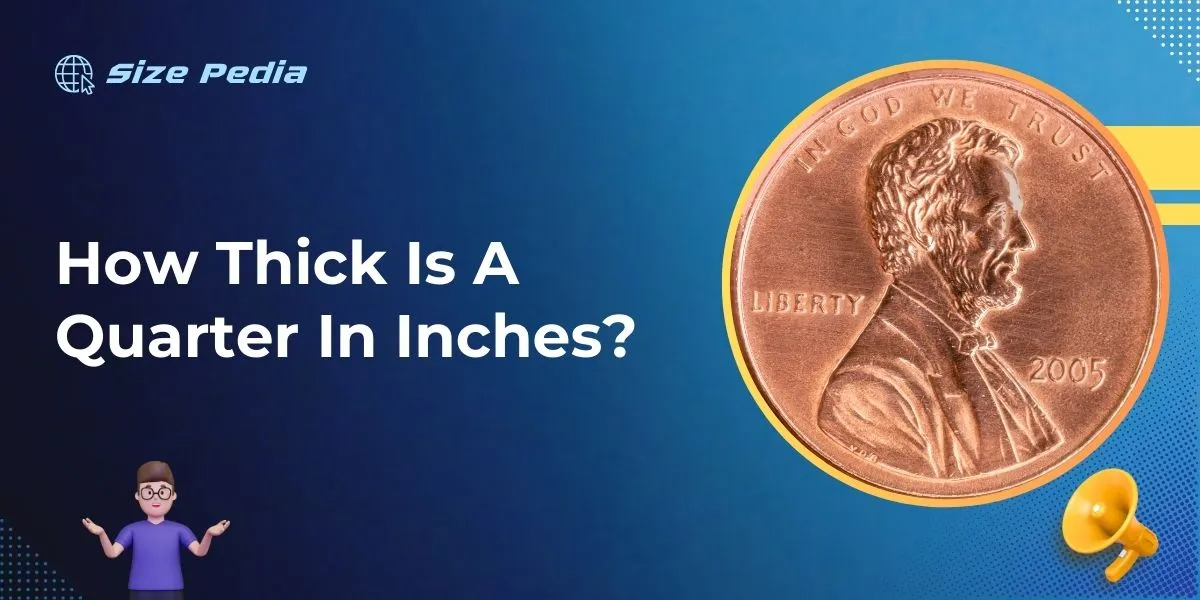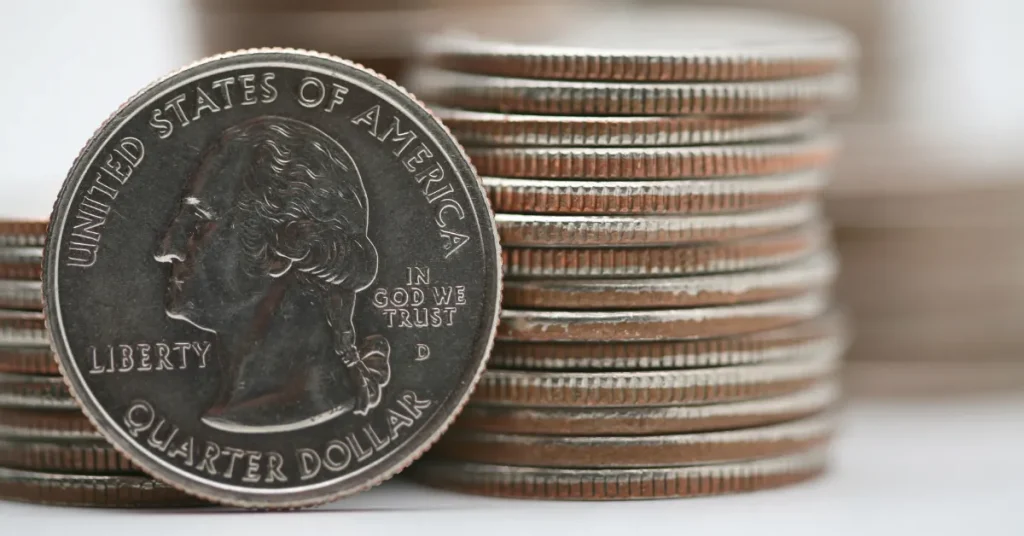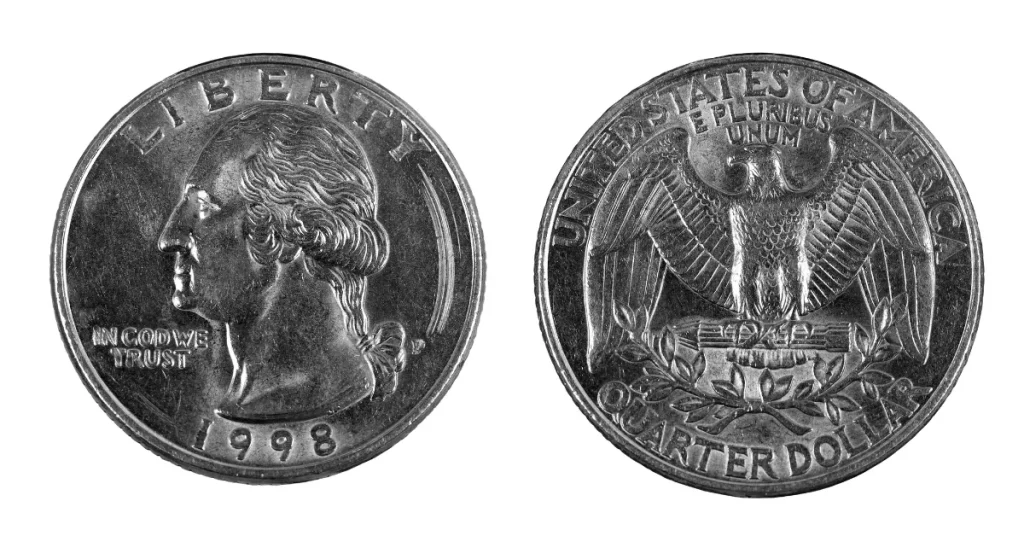A U.S. Quarter has a thickness of 0.069 inches. Its diameter extends to 0.955 inches across.
Understanding the dimensions of commonly used currency is helpful for multiple practical applications such as vending machines, coin sorting, and numismatic pursuits.
The quarter, officially known as the Washington quarter, plays a crucial role in American currency, easily recognizable by its size and engravings.
Despite its clout, the quarter maintains a modest physical profile with a precise thickness that ensures it fits smoothly in a variety of coin-operated devices.
Collectors and everyday users alike benefit from knowing these specific measurements, aiding in the identification and handling of the coin.
The United States Mint has standardized these dimensions to ensure uniformity across all quarters produced.
This uniformity is essential not only for consumers and collectors but also for maintaining the efficiency of cash-based transactions and machinery that rely on the consistent size of coins.

Unveiling The Thickness Of A Quarter
Industry Standards For Coin Dimensions
The United States Mint has strict guidelines for producing coins. These guidelines ensure that coins are uniform and reliable.
The quarter has a specific thickness set by these standards, which is crucial for vending machines and coin-operated devices.
Let’s look at how these standards apply to quarters. The standard thickness of a quarter is 1.75 millimeters.
When we convert millimeters to inches, it’s about 0.069 inches. This precision guarantees that every quarter feels and weighs the same.
Contrast With Other Us Coins
Quarters stack up interestingly against their coin relatives.
| Coin | Thickness (Inches) |
| Penny | 0.0598 |
| Nickel | 0.0768 |
| Dime | 0.053 |
| Quarter | 0.069 |
| Half Dollar | 0.085 |
| Dollar | 0.079 – 0.083 |
In comparison, pennies and dimes are thinner than quarters. Meanwhile, nickels, half dollars, and dollar coins are thicker.
This table offers a clear view of how quarters measure up against other coins.
The Quarter’s Profile

Ever held a quarter and wondered just how thick it is? You’re not alone! Let’s dive into the surprising dimensions of this everyday coin and its journey through history.
Material Composition Impact On Size
Did you know the stuff a quarter is made of can affect its thickness? Let’s break it down:
- Originally: Quarters were mostly silver.
- Today: They blend copper and nickel.
- Thickness: Despite material changes, the quarter remains 1.75 millimeters or roughly 0.0689 inches thick.
The makeup of metals ensures sturdy and consistent quarters for everyone.
The Quarter’s Evolution Over Time
From pure silver to a copper-nickel mix, the quarter has an evolution tale. Let’s glance at its timeline:
| Year | Composition | Thickness |
| 1796 | Silver | Varied |
| 1965 | Copper-Nickel | 1.75 mm |
| Today | Copper-Nickel | 1.75 mm |
Despite changes over centuries, the quarter has kept its hallmark thickness. Collectors and spenders rely on its familiar feel.
Measurement Techniques
Knowing the thickness of a quarter mainly helps in grading its condition. It involves precision, skill, and the right tools. You will now learn how to measure it like a pro.
Tools For Measuring Coin Thickness
Various tools help in measuring the thickness of a quarter. Let’s look at the most common ones:
- Vernier Caliper: Offers precise measurements.
- Micrometer: Provides extreme accuracy, down to .0001 inches.
- Ruler: A standard option, good for a rough estimate.
Accuracy In Coin Measurement
For accurate measurements, some steps are crucial:
- Place the coin on a flat surface.
- Ensure the tool is calibrated.
- Apply gentle pressure to avoid damage.
- Read measurement closely and note it down.
Remember, proper technique ensures the best accuracy in measurement.
Applications Of Coin Thickness Knowledge
Knowing the thickness of a quarter can be more useful than you might think. It seems like a small detail, but this information plays a crucial role in various day-to-day applications.
Let’s dive into how precisely measuring a coin’s thickness, particularly that of a quarter, affects different technological and educational facets.
Coin Sorting And Vending Machines
Coin-operated machines rely heavily on proper coin calibration. The thickness of a quarter, which is 1.75 millimeters or about 0.069 inches, must be accurately recognized for the smooth operation of these devices.
When you insert a coin into a vending machine, it goes through a meticulous verification process. Here is where thickness matters:
- Size Detection: Sensors measure the coin to confirm it matches a quarter’s dimensions.
- Weight Verification: The machine weighs the coin to prevent fraud.
- Material Analysis: Magnets or other methods check the coin’s material.
Many coin-operated machines, such as arcade games and laundry facilities, have similar systems. Without knowing the thickness of a quarter, creating and maintaining these machines would be much harder.
Educational Purposes And Numismatics
For educators and numismatists, or coin collectors, coin dimensions hold significant educational value.
Teachers use real-world examples like coin dimensions to explain measurement concepts. Students learn to measure and compare sizes through hands-on experience.
Coin collectors, on the other hand, examine coin specifications closely to assess rarity and condition.
In numismatics, understanding the minute details of each coin, including its thickness, is vital. Collectors use precision tools to measure coins to ensure authenticity.
| Coin | Thickness | Diameter | Weight |
| Quarter | 0.069 inches | 0.955 inches | 5.67 g |
| Dime | 0.053 inches | 0.705 inches | 2.268 g |
| Nickel | 0.077 inches | 0.835 inches | 5.00 g |
Accurate measurements of coins like the quarter foster learning and ensure the integrity of collections. Numismatics greatly values precision, turning simple thickness knowledge into a much-appreciated science.
Fun Facts About Quarters

Think quarters are just for spending? Think again! These coins are full of surprises. Let’s dive into some quirky truths about these everyday pocket dwellers.
Quarters In Popular Culture
Quarters pop up everywhere! From arcade games to wishing wells, they’re iconic. Let’s look at how they shine:
- Arcade Games: Quarters dominated the machines, buying us the joy of play.
- Music: Bands like ‘Quarterflash’ grabbed the name, showing the coin’s cultural imprint.
- Sayings: Ever hear “not worth a quarter”? It’s a staple in American sayings.
Unique Quarter Designs And Their Thickness
Quarters come in many designs, each with a story. They all share one trait—thickness.
| Design | Year | Thickness (in inches) |
| Standard Washington | 1932-present | 0.069 inches |
| 50 State Quarters | 1999-2008 | 0.069 inches |
| America the Beautiful | 2010-2021 | 0.069 inches |
Despite varied designs, all these quarters measure the same: a consistent 0.069 inches thick.
FAQs About How Thick Is A Quarter In Inches
What Is The Thickness Of A Quarter?
A U. S. quarter has a thickness of approximately 1. 75 millimeters.
What Size Is A Quarter In Inches?
A U. S. quarter has a diameter of 0. 955 inches (24. 26 millimeters).
How Many Inches Is A Quarter Coin?
A US quarter coin measures 0. 955 inches (24. 26 mm) in diameter.
How Thick Is A Dime In Inches?
A dime has a thickness of approximately 0. 053 inches.
Conclusion
Understanding the dimensions of everyday objects, such as a quarter, enriches our grasp of the physical world.
At 0. 069 inches thick, quarters are more than mere currency—they’re a tangible measure of American history in our pockets. Keep this fun fact handy; it’s a great conversation starter!
Resources:
1. https://www.usmint.gov/learn/coin-and-medal-programs/coin-specifications
